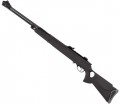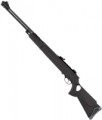Cheek adjustment
The ability to adjust the location of the emphasis under the cheek, located on the butt. Usually, we are talking about at least height adjustment, and in advanced models it may also be possible to move the stop back and forth. Anyway, this feature allows you to adjust the position of the cheek to the physique and personal preferences of a particular shooter, thus providing the most comfortable tab — and this convenience, in turn, has a positive effect on accuracy. At the same time, the ability to
adjust the cheekpiece significantly increases the price of the rifle, and therefore it is found mainly in top-class models.
Recoil pad/stock adjustment
The ability
to adjust the back of the stock mounted in the rifle.
Most often, we are talking about adjusting the length, which allows you to adjust the length of the butt to the growth and, accordingly, the length of the hands of a particular user. In some models, such adjustment is carried out due to the telescopic design of the butt itself, in others, interchangeable or retractable butt pads are provided. Anyway, this feature provides additional comfort when shooting. And it will be especially useful in two cases: if several people of different builds use the same rifle and if they have to shoot at different times of the year (in the latter case, the ability to adjust the stock depending on the thickness of the layer of clothing is useful).
In addition, more specific adjustments can be provided in modern pneumatics — for example, moving the butt plate up or down, used when shooting from non-standard positions or as an analogue of cheek adjustment (see above).
Barrel length
The working length of the rifle barrel is from the chamber where the bullet is loaded to the muzzle. The shortest barrels found nowadays have a length
of just over 200 mm(and in some AEGs even
less than this value); the longest reach
500 – 600 mm.
There is a stereotype that the muzzle velocity directly depends on the length of the barrel. In firearms, this is true — but not in pneumatics. Firstly, in such rifles, the initial velocity depends on a number of other indicators — pressure, the quality of the barrel treatment, the efficiency of the valves, etc. on the first 20 – 25 cm of the barrel, then the gas pressure drops noticeably. The exception is PCP rifles, in which the longer barrel really makes it easier to achieve high speeds. However, again, so many additional factors affect the final result that models with the same barrel length can differ markedly in initial speed.
The second common stereotype is that a longer barrel improves accuracy and accuracy. This is true in the context that a longer barrel allows for a greater distance between the front and rear sights, making it easier to aim carefully. Technical accuracy does not depend on the length, but on the quality of the barrel processing.
Summing up all of the above, we can say that the length of the barrel for an air rifle is more of a reference than a really significant paramete
...r, and when choosing, it is better to focus on more "close to life" characteristics — first of all, directly claimed muzzle velocity.
